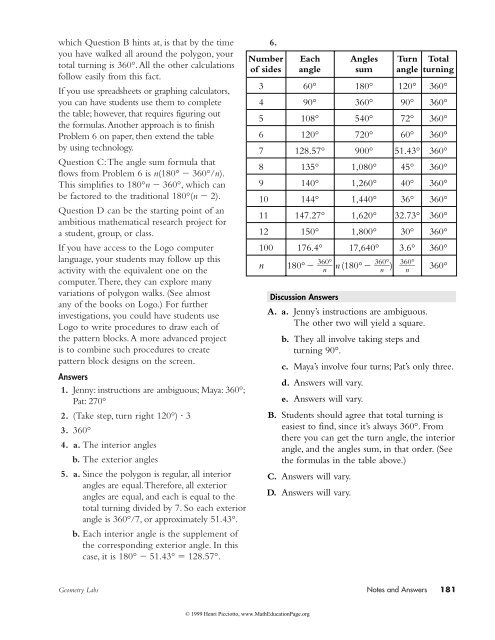Create successful ePaper yourself
Turn your PDF publications into a flip-book with our unique Google optimized e-Paper software.
which Question B hints at, is that by the time<br />
you have walked all around the polygon, your<br />
total turning is 360°.All the other calculations<br />
follow easily from this fact.<br />
If you use spreadsheets or graphing calculators,<br />
you can have students use them to complete<br />
the table; however, that requires figuring out<br />
the formulas.Another approach is to finish<br />
Problem 6 on paper, then extend the table<br />
by using technology.<br />
Question C:The angle sum formula that<br />
flows from Problem 6 is n(180° 360°/n).<br />
This simplifies to 180°n 360°, which can<br />
be factored to the traditional 180°(n 2).<br />
Question D can be the starting point of an<br />
ambitious mathematical research project for<br />
a student, group, or class.<br />
If you have access to the Logo computer<br />
language, your students may follow up this<br />
activity with the equivalent one on the<br />
computer.There, they can explore many<br />
variations of polygon walks. (See almost<br />
any of the books on Logo.) For further<br />
investigations, you could have students use<br />
Logo to write procedures to draw each of<br />
the pattern blocks.A more advanced project<br />
is to combine such procedures to create<br />
pattern block designs on the screen.<br />
Answers<br />
1. Jenny: instructions are ambiguous; Maya: 360°;<br />
Pat: 270°<br />
2. (Take step, turn right 120°) 3<br />
3. 360°<br />
4. a. The interior angles<br />
b. The exterior angles<br />
5. a. Since the polygon is regular, all interior<br />
angles are equal.Therefore, all exterior<br />
angles are equal, and each is equal to the<br />
total turning divided by 7. So each exterior<br />
angle is 360°/7, or approximately 51.43°.<br />
b. Each interior angle is the supplement of<br />
the corresponding exterior angle. In this<br />
case, it is 180° 51.43° 128.57°.<br />
6.<br />
Number Each Angles Turn Total<br />
of sides angle sum angle turning<br />
3 60° 180° 120° 360°<br />
4 90° 360° 90° 360°<br />
5 108° 540° 72° 360°<br />
6 120° 720° 60° 360°<br />
7 128.57° 900° 51.43° 360°<br />
8 135° 1,080° 45° 360°<br />
9 140° 1,260° 40° 360°<br />
10 144° 1,440° 36° 360°<br />
11 147.27° 1,620° 32.73° 360°<br />
12 150° 1,800° 30° 360°<br />
100 176.4° 17,640° 3.6° 360°<br />
n<br />
180° 36 0°<br />
n<br />
Discussion Answers<br />
A. a. Jenny’s instructions are ambiguous.<br />
The other two will yield a square.<br />
b. They all involve taking steps and<br />
turning 90°.<br />
c. Maya’s involve four turns; Pat’s only three.<br />
d. Answers will vary.<br />
e. Answers will vary.<br />
B. Students should agree that total turning is<br />
easiest to find, since it’s always 360°. From<br />
there you can get the turn angle, the interior<br />
angle, and the angles sum, in that order. (See<br />
the formulas in the table above.)<br />
C. Answers will vary.<br />
D. Answers will vary.<br />
n (180° 36 n<br />
0°<br />
) 36 0°<br />
n<br />
360°<br />
Geometry Labs Notes and Answers 181<br />
© 1999 Henri Picciotto, www.MathEducationPage.org






